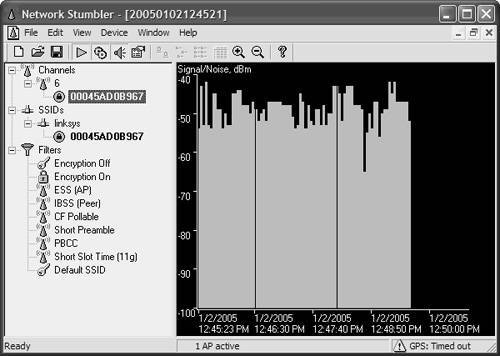Using Third-Party Tools
| After you build your WLAN, you need to continue ongoing performance tuning. You can make tuning significantly easier if you use tools, such as Perfmon, or establish and use a QoS plan. Third-party vendors offer several tools to tune a WLAN. These applications often mix performance and tuning tools; they detect radio signals; analyze individual broadcast packets; and offer a suite of security measures. As with QoS, you need to change your thought processes when you use these sorts of wireless performance tools. If you know how to use network analyzers in a wired network, remember that you cannot manage or track anything outside the RF range of these tools, even if it's still part of the WLAN. Therefore, be sure to move around your network to get optimal results. NetStumblerNetStumbler is a freeware tool for Windows that allows you to detect WLANs with 802.11a, 802.11b, and 802.11g technologies. The tool has numerous uses, including:
After it's activated, NetStumbler goes to work and detects all APs in the area. Figure 12-13 shows NetStumbler has detected an AP with the SSID linksys. Figure 12-13. NetStumbler Locates and Analyzes All APs It Can Hear NetStumbler enables you to examine the detected APs based on the channel they use by SSID, or via several different filters (for instance, by which APs have WEP keys activate and which do not). If you refer back to Figure 12-13 and select the AP with the MAC address of 00045AD0B967, it results in the display of statistics that show the AP's broadcast signal to noise ratio. This is useful when you locate your own APs because you can find where the signal strength is best, and where it needs improvement. AirMagnetThe AirMagnet laptop and handheld analyzers can diagnose and troubleshoot WLANs from any Windows-based laptop or pocket PC. The analyzers can track security issues (such as policies, rogue devices, and network vulnerabilities) and performance problems. AirMagnet monitors WLAN performance with over 40 alerts for various situations, including:
Each alert is accompanied with a detailed description of the problem and diagnostic data and suggestions for correcting the problem. Additionally, AirMagnet can track performance for individual channels. For example, if channel 6 is bogged down because of interference, broadcast storms, and low transmission rates, the application can alert users to the situation. Additionally, you can monitor multiple channels simultaneously and display the results for analysis. Other WLAN performance-enhancing features of AirMagnet include:
Sniffer WirelessNetwork General offers Sniffer Wireless application, a third-party WLAN performance monitoring tool. Sniffer can identify security concerns, as well as network performance problems. It is used with Windows-based laptops and handheld PCs, and it's compatible with Cisco wireless cards. The following outlines Sniffer's features:
In addition to its WLAN performance duties, Sniffer Wireless can also identify security concerns, to include rogue AP detection. If you want to keep your WLAN running optimally, it requires periodic examination and adjustment. If you use tools, such as Perfmon, the Cisco site survey tool, or any of the other tools examined in this chapter, your WLAN can perform optimally. |
EAN: 2147483647
Pages: 126